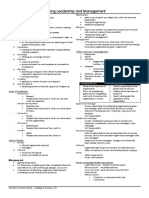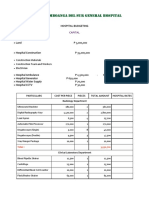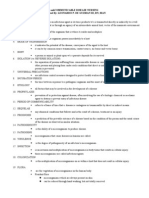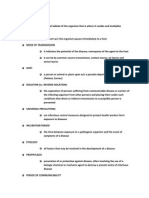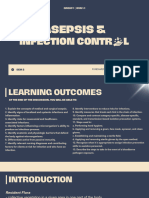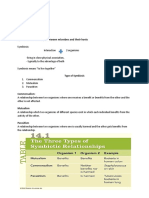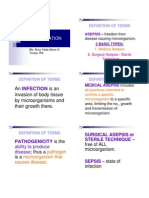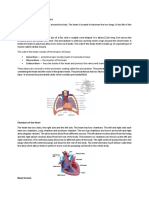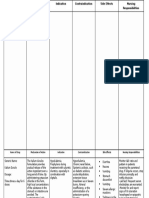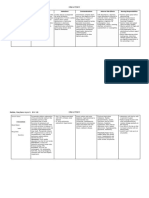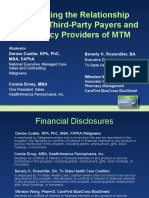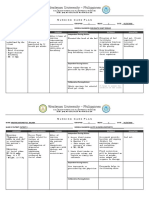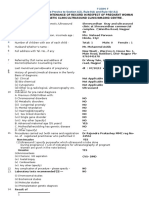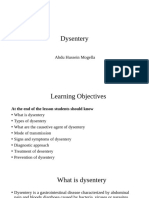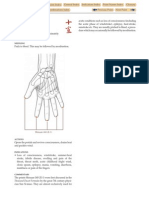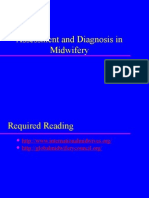Communicable & Infectious Diseases
Communicable & Infectious Diseases
Uploaded by
hahahahaaaaaaaCopyright:
Available Formats
Communicable & Infectious Diseases
Communicable & Infectious Diseases
Uploaded by
hahahahaaaaaaaOriginal Description:
Original Title
Copyright
Available Formats
Share this document
Did you find this document useful?
Is this content inappropriate?
Copyright:
Available Formats
Communicable & Infectious Diseases
Communicable & Infectious Diseases
Uploaded by
hahahahaaaaaaaCopyright:
Available Formats
NCM 104CARE of CLIENTS with PROBLEMS in INFLAMMATORY Direct contact-person to personIndirect contact-usually an
& IMMUNOLOGIC RESPONSE inanimate object
Droplet contact-from coughing, sneezing, or talking by an
COMMUNICABLE & INFECTIOUS DISEASES infected person
In general, COMMUNICABLE DISEASE is an illness due to an Vehicle Route food-salmonellosis water- shigellosis,
infectious agent or its toxic products w/c is transmitted directly or legionellosis drugs- bacteremia resulting from infusion of a
indirectly to a susceptible person or animal or through an contaminated infusion product blood- hepatitis B, or non-A non-
agency of an intermediate animal host, vector or the inanimate B hepatitis
environment. Airborne Transmission Droplet nuclei-dried residue formed by
CONTAGIOUS vs. INFECTIOUS CONTAGIOUS evaporation of droplets cough or sneezed Organisms shed into
applied to disease that are easily spread directly transmitted environment from-skin-hair-wounds or -perineal areaDust
from person-to-person particles-air containing the infectious agent
INFECTIOUS are those disease not transmitted by ordinary Vector Transmission-via contaminated or infected arthropods
contact, but require a direct inoculation through a break in the such as: flies, mosquitoes, ticks, etc.
previously intact skin or mucous membrane
INFECTIOUS AGENTS Mode of Escape from Reservoir
Agents that produce infections can consist of Respiratory tract,GI tract,GU tract, Open lesion Mechanical
bacteria,viruses,fungi,protozoa,rickettsia,chlamydia escape - bites from insects, Blood
The ability of a microorganism to infect a client is related to:
Pathogenicity-ability to cause disease Mode of Entry into Human Body
Virulence-disease severity Respiratory tract, GI tract, GU tract, Mucous membrane or skin,
Invasiveness-ability to enter and move through the tissue Placenta
Infective Dose-number of organisms needed to initiate infection
Organism Specificity-host preferenceSusceptibility of the Host Susceptible Host
INFECTIOUS AGENTS are pathogenic microorganisms A person with a reduced immune response has increased
producing disease. susceptibility.The immune response is the body’s natural
Bacteria- a simple, one-celled microbe with double cell defense against infection.
membrane that protect them from harm. They reproduce rapidly
and considered as the most common cause of fatal infectious ESSENTIAL ELEMENTS IN C.D.
diseases. They are classified according to: Shape- cocci, bacilli, HOST, AGENT & ENVIRONMENT
spirillae Need for O2- aerobic, anaerobicResponse to staining-
gram +, gram – or acid fastMotility- motile, non motileTendency Factors Influencing Production of an Infectious Disease Age,
to capsulate- encapsulated, capsulatedCapacity to form spore- Heredity, Stress, Surgery, Nutrition Health Status
spore forming, non spore forming
Rickettsiae- small, gram (–) bacteria-like microbe that can
Four Stages of Infection
induce life-threatening infections. Like viruses, they require a
host’ cell for replication. These are usually transmitted through Incubation,Prodroma, lIllness, Convalescence
bite of arthropod carrier like flea, ticks, lice as well as through
waste products. DEFENSE MECHANISM OF THE BODY
Spirochete- are bacteria with flexible, slender, undulating spiral Normal Defense Mechanisms
rods that possess cell wall. (treponema, leptospira, borilla) Non-specific immune defenses
Viruses- the smallest known microbe. They can’t replicate Specific immune defenses
independently in the host’s cells and stimulate it to participate in
the formation of additional viruses.Chlamydia- smaller than Nonspecific Defense Mechanisms
rickettsiae but larger than viruses. -Protect the host from all microorganisms-Not dependent on
Fungi- found almost everywhere on earth. They live in soil, prior exposure to the antigen
water or animals and plants. They also live inside or outside Skin and Normal FloraTearing Reflexes Elimination Acidic
human body. Environment Mucous Membranes Sneeze, Cough Reflexes
Protozoa- much larger than bacteria. The simplest single-celled Inflammatory Response
organism of animal kingdom. Parasitic protozoa absorb nutrients Skin Intact skin is the body’s first line of defense against
from the body of the host. (amoeba) infection. Sebum is produced by the skin and contains fatty
Parasite- live on or within other organisms, live on the expenses acids that kill some bacteria.
of others. They don’t kill the host but take the nutrients they Normal Flora Normal flora residing on the skin compete with
need. (tapeworms, hair/body lice, skin mites) pathogenic flora for food and inhibit their
multiplication.Inappropriate antibiotic use may disrupt the
SOURCE or RESERVOIR the environment and objects on which balance of normal flora.
an organism can survive or multiply. Mucous Membranes Mucus entraps infectious agents and
HUMAN RESERVOIR contains substances that inhibit bacterial growth. Cilia trap and
FRANK CASES- very ill propel mucus and microorganisms away from the lungs.
SUB-CLINICAL – ambulatory Sneeze and Cough Reflexes Physically expel mucus and
CARRIER microorganisms from the respiratory tract and oral cavity with
INCUBATORY CARRIER- one who is incubating the illness force
Tearing Reflex Protects the eyes by continually flushing away
CONVALESCENT CARRIER- the recovery stage of illness but microorganisms
continue to shed the pathogenic microorganism Elimination Patterns and Acidic Environment Resident flora of
INTERMITTENT CARRIER-occasionally shed the microbes the large intestines Mechanical process of defecation Flushing
CHRONIC/SUSTAINED CARRIER- always has the microbes in action of urination Acidic environment of urine and vagina
his system. Inflammatory Response Tissue injury caused by bacteria,
trauma, chemicals, heat, or any other phenomenonRelease of
substances that produce secondary changes in the tissue
ANIMAL RESERVOIRNON-LIVING
MODE OF TRANSMISSION
Specific Immune Defense (The Immune Responses) Immunity
Route of Transmission Contact TransmissionAirborne
is a specific defense mechanism that creates an immune
TransmissionVehicle RouteVector-borne Transmission
response to a specific invading antigen. Immune Responses:
Contact Transmission
Active immunityPassive immunity Natural immunity Artificial NATIONAL AND INTERNATIONAL CONTROL PROGRAMS
immunity DOH Maternal & Child health care programs including Family
Active immunity results from the development within the body of Planning
antibodies that neutralize the infective agent.Passive immunity is TB Control Program
acquired by the introduction of preformed antibodies.Acquired Control of Diarrheal Diseases
immunity results either from exposure to an antigen or from the Malaria Control Program
passive injection of immunoglobulins.Natural immunity refers to
Schistosomiasis Control Program
the genetically determined response of protection within a
Legislation of Sanitation
specific species.Artificial immunity is produced following a
vaccine. CodeEPI (Expanded Program on Immunization)
The Humoral Immune Response - B lymphocytes recognize the WHO Maternal & Child health programs
antigen as an enemy.Immunoglobulins are plasma protein cells EPI Primary Health Care
that produce five different classes of antibodies (IgG, IgA, IgM, Control of CD
IgE, and IgD).GAMED Immunoglobulins circulate throughout the Biologic standards for vaccines and other products
bloodstream for the purpose of destroying antigens.
Cell-Mediated ImmunityFights pathogens that survive inside SPECIFIC DISEASES
cells.Antigen stimulates the release of activated T cells.-T-helper
cells-T-suppressor cells-T-cytotoxic cells INFLUENZA (LA GRIPPE, FLU)
An acute, highly contagious infection affecting respiratory
PERSONAL PROTECTIVE EQUIPMENTS (3G,MC) GLOVES tractCausative Agent: RNA containing myxovirus
GOWNS GOGGLES MASK CAP influenzaeType A viruses –strikes q year; most common H1N1
Reduce/Eliminate Infectious Agents → hemaglutinin (H) and the neuraminidase (N). H2N2 H3N3
CLEANSING –removal of soil or organic material from Type B Type C
instruments & equipment used in providing care using water. May be sporadic or endemicRemarkable features of Flu:
DISINFECTION -elimination of pathogens, except spores, from capacity for Antigenic Variation: A. Antigenic drift- yearly or
inanimate objects by the use of germicides and antiseptics. every few yearsB. Antigenic shift- changes that lead to
STERILIZATION- a method for the total elimination of all pandemics
microorganisms including spores. INCUBATION PERIOD 1-5 Days
PERIOD OF COMMUNICABILITY 3-5 daysUp to 7 days in
COMMUNITY REACTION children
SPORADIC- intermittent occurrence of particular disease in a PREVENTION Avoid crowded places Personal hygiene Flu
particular/ specific area ( Tetanus, salmonelliosis) vaccine
ENDEMIC- the habitual presence of a disease in a certain SIGNS AND SYMPTOMS HeadacheLoss of appetite Malaise
locality (Cholera, Typhoid) Coryza Cough Fever Weakness Sore throat Myalgia
EPIDEMIC- the occurrence of cases of similar nature in human LABORATORY WBC usually normal but with increase WBC-
population in particular area in excess of usual incidence bacterial infection
(Dengue, meningococcemia) RESERVOIR: Man
PANDEMIC- the occurrence of a disease in several countries or MODE OF TRANSMISSION May persist for hour in mucus
continents (SARS, Bird’s flu, AIDS) Airborne Direct through droplet
TREATMENT
PREVENTION AND CONTROL Acetamenophen for fever, headache and myalgia Cough syrup
PRIMARY PREVENTION-is done pre-pathogenesis by for dry hacking coughAmantidine or Rimantadine- reduces
promoting general optimum health care and specific protection.- symptoms and virus titers in respiratory secretions
HEALTH PROMOTION-SPECIFIC PROTECTIONSECONDARY NURSING MANAGEMENT
PREVENTION- early diagnosis and treatment (as soon as IsolationRestIncrease fluid intakeProper nutritionUse vaporizer
disease is detectable early in pathogenesis)TERTIARY to reduce respiratory irritation
PREVENTION- corrective therapy (rehabilitation, disability COMPLICATIONS
limitation) Hemorrhagic pneumoniaEncephalitisMyocarditisSudden infant
death syndrome Otitis media Sinusitis Pneumonia
Role of Health Care Personnel and Health Agencies in
Infection Control PULMONARY TUBERCULOSIS
Reinforce adherence to isolation. An acute or chronic infection
Post signs indicating type of isolation. Causative agents: Mycobacterium tuberculosis from humans;
Provide necessary supplies. M. bovis/africanum from cattle
Place clients in a private room with adequate ventilation. Types: Extrapulmonary Pulmonary
Use disposable supplies and equipment. Modes of Transmission Airborne Direct contact - kissing
Labeling of all articles leaving the room Incubation Period 4-12 weeks
Use of impermeable bags or double bagging Period of Communicability As long as live microorg are present
Client and family instruction in sputumAntimicrobial drug therapy reduces communicability
Alert to psychological discomfort within days after initiation of treatment
Pathogenesis
ROLE OF FAMILY & COMMUNITY IN PREVENTION & CONTROL 1. Droplet nuclei- sneezing/coughing
OF C.D. 2. Cavity lesions-produce 1 million to 100 million tubercle bacilli
FAMILY PROVIDES per ml
Adequate nutrition 3. Once inhaled, bacilli settles in alveolus causing infectionCell-
Finances for periodic examination mediated immunity-may arrest the disease (3-6wks)
Means for children’s immunization 4. If infection reactivates, body’s response leads to caseation
Personal hygiene for children 5. The caseum may localize, undergo fibrosis, or excavate and
Sanitary environment form cavities- the walls are studded with multiplying tubercle
COMMUNITY PROVIDES bacilli
Health care facilities 6. Infected caseous debris may spread throughout the lungs
Recreational facilities Signs & SymptomsNon-specific symptoms:Fatigue Weakness
Anorexia Weight loss Night sweats Low-grade fever
Housing facilities
Reactivation:Cough- Mucopurulent sputum Hemoptysis Chest Why is this new H1N1 virus sometimes called “swine flu”?This
pains virus was originally referred to as “swine flu” because laboratory
Diagnostic Tests Chest x-ray- nodular lesions, patchy infiltrates, testing showed that many of the genes in this new virus were
scar formationTuberculin Skin Test/Mantoux Test- 5-15 mm very similar to influenza viruses that normally occur in pigs in
induration is positive reactionSputum smears/culture- shows North America. But further study has shown that this new virus
heat-sensitive, nonmotile, anaerobic, acid-fast bacilli is very different from what normally circulates in North American
Only contraindication for SPUTUM EXAM: massive hemoptysis pigs. It has two genes from flu viruses that normally circulate in
Direct sputum smear exam :is the principal diagnostic method pigs in Europe and Asia and avian genes and human genes.
adapted by the NTP because of the ff reasons: Microscopy Scientists call this a "quadruple reassortant" virus
center in remote areas Economical Definitive diagnosis of active What are the signs and symptoms of this virus in people?similar
TBSimple procedure to the symptoms of seasonal flu and include:fever, cough, sore
TREATMENT throat, runny or stuffy nose, body aches, headache, chills and
Anti-TB drugsIsoniazid (INH)Rifampicin (RIF)Pyrazinamide fatigue. A significant number of people reported diarrhea and
vomiting. Also, like seasonal flu, severe illnesses and death has
(PZA)Ethambutol (etham)Drug-resistant
TBStreptomycinQuinolone drugsAmikacin occurred as a result of illness associated with this virus. Take
these everyday steps to protect your health:Cover your nose
Gen objective of Case Finding: early identification & diagnosis of
and mouth with a tissue when you cough or sneeze. Throw the
TB casesCase finding refers to the activities that aim to
tissue in the trash after you use it. Wash your hands often with
find/discover TB casesThe main activities of Case finding are
soap and water, especially after you cough or sneeze. Alcohol-
sputum exam and chest x-ray
based hand cleaners are also effective. Avoid touching your
Nursing managementMaintain respiratory isolation until patient eyes, nose or mouth. Germs spread this way. Try to avoid close
responds to treatment or until the patient is no longer contact with sick people. Stay home if you are sick for 7 days
contagious.Administer medicines as ordered.Always check after your symptoms begin or until you have been symptom-free
sputum for blood or purulent expectoration.Encourage for 24 hours, whichever is longer.
questions and conversations so that the patient can air her
Are there medicines to treat infection with this new virus?
feelings.Teach or educate the patient all about PTB.Encourage
to stop smokingTeach to cough or sneeze into tissue paper and Yes. CDC recommends the use of oseltamivir or zanamivir for
dispose secretions properly.Advise patient to have plenty of rest the treatment and/or prevention of infection with the new H1N1
flu virus. Antiviral drugs are prescription medicines (pills, liquid
and eat balance meals.Be alert of signs of drug
reaction.Emphasize the importance of regular follow up or an inhaler) that fight against the flu by keeping flu viruses
examinations and instruct the patient and his family about the from reproducing in your body.
signs & symptoms of recurring TB.
PNEUMONIA
An acute infection of the lung parenchyma; impairs gas
exchange
Etiology: Microbiologic- viral, bacterial, fungal, protozoal,
mycobacterial, mycoplasmal, rickettsial
Location: Bronchopneumonia- distal airways and alveoli Lobular
Pneumonia- part of a lobe Lobar Pneumonia-
entire lobe
CAUSATIVE AGENTS :STREPTOCOCCUS
PNEUMONIAESTAPHYLOCOCCUS AUREUSHEMOPHILUS
INFLUENZAEKLEBSIELA PNEUMONIAE (FRIEDLANDER’S
BACILLI)
Types:
Primary Pneumonia- inhalation or aspiration of
pathogenSecondary Peumonia- follows initial lung damage from
chemical or superinfection
PREDISPOSING FACTORS
BACTERIAL/VIRAL Chronic illness/debilitationCancerAbdominal
& Thoracic surgeryAtelectasisCommon colds/ viral respiratory
infectionsCOPDInfluenzaMalnutritionSmoking
ASPIRATION PNEUMONIA Old age Debilitation NGT feedings
Impaired Gag reflex Poor oral hygiene Decreased LOC
CLINICAL MANIFESTATIONS
CARDINAL SYMPTOMS:CoughingSputum production –rusty
sputum (PS)Chest painShaking chills Fever
COMPLICATIONS:Hypoxemia Respiratory failure Pleural
effusion Bacteremia
DIAGNOSIS
Sputum exam Chest X-ray Clinical features
TREATMENT: Antimicrobial therapy- varies with CA Supportive
therapy Bed rest
NURSING CONSIDERATIONS: Maintain patent airway
Measure ABG as ordered Deep breathing exercises Coughing
exercises Adequate nutrition If on mechanical ventilator-
suctionBed rest
What is H1N1 (swine flu)?
H1N1 (referred to as “swine flu” early on) is a new influenza
virus causing illness in people. This new virus was first detected
in people in the United States in April 2009. Other countries,
including Mexico and Canada, have reported people sick with
this new virus. This virus is spreading from person-to-person,
probably in much the same way that regular seasonal influenza
viruses spread.
You might also like
- Hospital Nursing Service Admin ManualDocument217 pagesHospital Nursing Service Admin Manualloveseeker0684% (58)
- Nursing Leadership and Management PDFDocument10 pagesNursing Leadership and Management PDFhahahahaaaaaaa100% (12)
- Cervical and Thoracic Spine Disorders GuidelineDocument711 pagesCervical and Thoracic Spine Disorders GuidelineRandy MarmerNo ratings yet
- Communicable Disease Nursing Ca1 July 2018 5 PDFDocument461 pagesCommunicable Disease Nursing Ca1 July 2018 5 PDFJordz Placi100% (4)
- Hospital Budgeting: - Construction Materials - Construction Team and Workers - ElectricianDocument11 pagesHospital Budgeting: - Construction Materials - Construction Team and Workers - ElectricianhahahahaaaaaaaNo ratings yet
- Zamboanga Del Sur General Hospital: Staff Nurse Performance Evaluation SheetDocument5 pagesZamboanga Del Sur General Hospital: Staff Nurse Performance Evaluation Sheethahahahaaaaaaa100% (1)
- CHN Lecture SY2015-2016 1 SemesterDocument141 pagesCHN Lecture SY2015-2016 1 SemesterhahahahaaaaaaaNo ratings yet
- Fundamentals Reviewer Finals Finals FinalsDocument14 pagesFundamentals Reviewer Finals Finals Finalsleahrico1964No ratings yet
- ENTEROBACTERIADocument3 pagesENTEROBACTERIAKat Su MiNo ratings yet
- Asepsis and Infection PreventionDocument31 pagesAsepsis and Infection PreventionPamela Ria HensonNo ratings yet
- NCM 104 - RleDocument25 pagesNCM 104 - RleAbigael Patricia GutierrezNo ratings yet
- Funda MidtermsDocument60 pagesFunda MidtermsMina ParkNo ratings yet
- Communicable Disease ReviewerDocument18 pagesCommunicable Disease ReviewerMicah Jonah Elicaño100% (1)
- Oralhygiene 2Document36 pagesOralhygiene 2irren27No ratings yet
- Communicable DiseasesDocument2 pagesCommunicable DiseasesJayzelle Anne de LeonNo ratings yet
- Immunity: Presented By: DR - Reena Rani PG1 Year Pediatric and Preventive DentistryDocument137 pagesImmunity: Presented By: DR - Reena Rani PG1 Year Pediatric and Preventive DentistryReenaChauhanNo ratings yet
- Prevention and TreatmentDocument7 pagesPrevention and TreatmentAlexander EnnesNo ratings yet
- Chapter 10 - Diseases & Immunity - Cecilia Benita 2Document19 pagesChapter 10 - Diseases & Immunity - Cecilia Benita 2simplyjisungNo ratings yet
- Rle - Asepsis and Infection ControlDocument36 pagesRle - Asepsis and Infection ControlAngelyn SalimbajonNo ratings yet
- Micro para 5Document7 pagesMicro para 5Reselle EspirituNo ratings yet
- Mid FundaDocument17 pagesMid FundamilescoducoNo ratings yet
- Communicable Diseases Handouts)Document15 pagesCommunicable Diseases Handouts)snpjavierNo ratings yet
- CHN Final TopicsDocument52 pagesCHN Final TopicsMary Ann SacramentoNo ratings yet
- Infection and Its Mode of TransmissionDocument33 pagesInfection and Its Mode of TransmissionAnusha Verghese100% (2)
- Microbiology & Parasitology 3Document3 pagesMicrobiology & Parasitology 3Christine MagbataNo ratings yet
- Infection Prevention ControlDocument9 pagesInfection Prevention ControlIchilon Tamoto0% (1)
- Patient, CarrierDocument5 pagesPatient, CarrierJoeLec ViloriaNo ratings yet
- Introduction To Clinical MicrobiologyDocument27 pagesIntroduction To Clinical MicrobiologySummayya Kanwal AhmadNo ratings yet
- Human Health and DiseaseDocument54 pagesHuman Health and DiseaseTirth TupeNo ratings yet
- Asepsis and Infection ControlDocument8 pagesAsepsis and Infection ControlELATVNo ratings yet
- ASEPSIS Funda ReviewerDocument7 pagesASEPSIS Funda ReviewerAlexies Jyne DalopeNo ratings yet
- Trances-Inflam Mod1Document4 pagesTrances-Inflam Mod1Shannon YapNo ratings yet
- Introduction To Microbiology ReviewerDocument2 pagesIntroduction To Microbiology ReviewerYram Yoj D. TamayoNo ratings yet
- Transes-Funda Rle PrelimsDocument12 pagesTranses-Funda Rle Prelimsmikhyla.cardenoNo ratings yet
- 1-7 Page Aralin Niyo HeheDocument7 pages1-7 Page Aralin Niyo Hehellanamari.cotacoNo ratings yet
- Chapter 13Document32 pagesChapter 13Kat KatNo ratings yet
- Communicable DiseasesDocument9 pagesCommunicable Diseaseskatz_hotchickNo ratings yet
- Funda MidtermDocument21 pagesFunda MidtermTrisha ApalisNo ratings yet
- Cb1 Host-Microbe InteractionDocument2 pagesCb1 Host-Microbe InteractionAngelic AngelesNo ratings yet
- Asepsis and InfectionDocument6 pagesAsepsis and InfectionMabes100% (1)
- Reviewer in MicroparaDocument7 pagesReviewer in MicroparaLore FraginalNo ratings yet
- Chapter 10 Immunity Grade 10Document36 pagesChapter 10 Immunity Grade 10gabiplayz47No ratings yet
- Funda NotesDocument4 pagesFunda Notesloviamae.belizarNo ratings yet
- Disease and Immunity PDFDocument21 pagesDisease and Immunity PDFwondersinpreparationforfoodNo ratings yet
- Micropara 1Document8 pagesMicropara 1flixiexpressNo ratings yet
- Group 1 Asepsis Infection ControlDocument63 pagesGroup 1 Asepsis Infection Controljaslynnpinto132004No ratings yet
- Microbiology: Symbiotic Relationships Between Microbes and Their HostsDocument15 pagesMicrobiology: Symbiotic Relationships Between Microbes and Their HostsRAFAELLA SALVE MARIE GAETOSNo ratings yet
- Concept Communicable DiseasesDocument477 pagesConcept Communicable DiseasesrimeoznekNo ratings yet
- Infection & ImmunityDocument19 pagesInfection & ImmunitySAMUELNo ratings yet
- Communicable Disease Nursing Ca1 July 2018 5Document461 pagesCommunicable Disease Nursing Ca1 July 2018 5Jordz PlaciNo ratings yet
- Inflammation: InfectionDocument11 pagesInflammation: InfectionRenBautistaNo ratings yet
- Communicable Disease Nursing-Rn2024Document53 pagesCommunicable Disease Nursing-Rn2024SammNo ratings yet
- Funda Lec FinalsDocument9 pagesFunda Lec FinalsdencesoberanoNo ratings yet
- Year 10 DPP Biology Term 3 Exam RevisionDocument8 pagesYear 10 DPP Biology Term 3 Exam RevisionPoojit VenugopalaNo ratings yet
- المحاضرة التاسعةDocument7 pagesالمحاضرة التاسعةabdohakimaldamagiNo ratings yet
- Lec # 4 Body Defence SystemsDocument31 pagesLec # 4 Body Defence SystemssamotherlianNo ratings yet
- IPC Orientation 2023 IntensiveDocument155 pagesIPC Orientation 2023 Intensivealfio malinaoNo ratings yet
- ASEPSISDocument41 pagesASEPSISEVRMC ICSNo ratings yet
- Human Health and DiseaseDocument54 pagesHuman Health and Diseaseayushtak001No ratings yet
- Principles of EpidemiologyDocument23 pagesPrinciples of EpidemiologyGabz GabbyNo ratings yet
- Principles of Infection: Nevada Health ScienceDocument26 pagesPrinciples of Infection: Nevada Health Sciencejustin_saneNo ratings yet
- MODULE 1 and 2 RevisedDocument50 pagesMODULE 1 and 2 RevisedMaricar RosasNo ratings yet
- Infection ControlDocument64 pagesInfection Controlgn2hknwy7kNo ratings yet
- Pathology of InfectiousDocument39 pagesPathology of InfectiousDeEo OnoNo ratings yet
- The Patient From Becoming Re-Infected and The Infection From Spreading To Other PersonsDocument13 pagesThe Patient From Becoming Re-Infected and The Infection From Spreading To Other PersonshahahahaaaaaaaNo ratings yet
- Vaccination: How Millions of Lives Have Been Saved - Perhaps YoursFrom EverandVaccination: How Millions of Lives Have Been Saved - Perhaps YoursNo ratings yet
- CefuroximeDocument1 pageCefuroximehahahahaaaaaaaNo ratings yet
- Balance, Posture and Body AlignmentDocument6 pagesBalance, Posture and Body AlignmenthahahahaaaaaaaNo ratings yet
- PantoprazoleDocument1 pagePantoprazolehahahahaaaaaaaNo ratings yet
- Escavape Cloud RoomDocument2 pagesEscavape Cloud RoomhahahahaaaaaaaNo ratings yet
- Fluids and Electrolytes: 2. Interstitial SpaceDocument13 pagesFluids and Electrolytes: 2. Interstitial Spacehahahahaaaaaaa100% (1)
- Biodata and AnaphyDocument3 pagesBiodata and AnaphyhahahahaaaaaaaNo ratings yet
- FilariasisDocument11 pagesFilariasishahahahaaaaaaa100% (1)
- Composition Qualifications and Terms of HRDocument2 pagesComposition Qualifications and Terms of HRhahahahaaaaaaaNo ratings yet
- Drug TableDocument1 pageDrug TablehahahahaaaaaaaNo ratings yet
- Service Ward FebruaryDocument1 pageService Ward FebruaryhahahahaaaaaaaNo ratings yet
- The Wall of The Heart Consists of Three Layers of TissueDocument4 pagesThe Wall of The Heart Consists of Three Layers of TissuehahahahaaaaaaaNo ratings yet
- 3C Drug StudyDocument2 pages3C Drug StudyhahahahaaaaaaaNo ratings yet
- Journal Headnusring 4CDocument1 pageJournal Headnusring 4ChahahahaaaaaaaNo ratings yet
- Radiologic Technologist Job DescriptionDocument1 pageRadiologic Technologist Job DescriptionhahahahaaaaaaaNo ratings yet
- Policies and Procedures Manual 2017-2018Document43 pagesPolicies and Procedures Manual 2017-2018gus_lionsNo ratings yet
- Ultimate Performance Task in Health 7 Sy-2021-2022Document5 pagesUltimate Performance Task in Health 7 Sy-2021-2022Cris CabreraNo ratings yet
- HPB Assignment 2017Document7 pagesHPB Assignment 2017smoooth-operator493No ratings yet
- Accident 2Document5 pagesAccident 2oloyede_wole3741No ratings yet
- WJG 27 7661Document9 pagesWJG 27 7661Albert OkwareNo ratings yet
- Mapeh 4 Second Quarter Summative TestDocument10 pagesMapeh 4 Second Quarter Summative TestRosalyn Vidal RiveraNo ratings yet
- Navigating The Relationship Between Third-Party Payers and Pharmacy Providers of MTMDocument29 pagesNavigating The Relationship Between Third-Party Payers and Pharmacy Providers of MTMgmajdalaniiNo ratings yet
- Li Et Al. 2023Document9 pagesLi Et Al. 2023Gabriela VazquezNo ratings yet
- Rib Cage CoursesDocument11 pagesRib Cage CoursesPBNo ratings yet
- Caring For The Child With A Neurological or Sensory ConditionDocument48 pagesCaring For The Child With A Neurological or Sensory ConditionGlory MimiNo ratings yet
- UG ScheduleDocument1 pageUG ScheduleThe.darsh07No ratings yet
- Prostate PowerpointDocument9 pagesProstate PowerpointOkafor AugustineNo ratings yet
- Wesleyan University - Philippines: N U R S I N G C A R e P L A NDocument2 pagesWesleyan University - Philippines: N U R S I N G C A R e P L A NKristine CastilloNo ratings yet
- Form For Maintenance of Record in Respect of Pregnant Woman by Genetic Clinic/Ultrasound Clinic/Imaging CentreDocument2 pagesForm For Maintenance of Record in Respect of Pregnant Woman by Genetic Clinic/Ultrasound Clinic/Imaging CentreAnand ChineyNo ratings yet
- Nicolaus Et Al 2022 Definition of Patient Complexity in Adults A Narrative ReviewDocument13 pagesNicolaus Et Al 2022 Definition of Patient Complexity in Adults A Narrative ReviewMarli VitorinoNo ratings yet
- MEHLMANMEDICAL Microbiology Assessment 1 1Document75 pagesMEHLMANMEDICAL Microbiology Assessment 1 1Feroz RaZa SoomrOoNo ratings yet
- Curs Engleza 2014 PDFDocument263 pagesCurs Engleza 2014 PDFDeea TrancăNo ratings yet
- DAFTAR PUSTAKA Case BronkiolitisDocument2 pagesDAFTAR PUSTAKA Case BronkiolitisAnilNo ratings yet
- DysenteryDocument19 pagesDysenteryHussein AbduNo ratings yet
- Azmat Majeed 17-1-2006Document10 pagesAzmat Majeed 17-1-2006M. Haseeb SaqibNo ratings yet
- WINS Completion Report 2020 2021Document2 pagesWINS Completion Report 2020 2021richelle santiago100% (1)
- Shixuan (M Ue 1)Document1 pageShixuan (M Ue 1)md_corona62No ratings yet
- Assessment and Diagnosis in MidwiferyDocument19 pagesAssessment and Diagnosis in MidwiferyEvy WulandariNo ratings yet
- TSPSC Staff Nurse Notification PDF 2023Document26 pagesTSPSC Staff Nurse Notification PDF 2023venkat raj100% (1)
- Kadam, L. Et Al (2019)Document21 pagesKadam, L. Et Al (2019)ADELIA MARIA DA SILVANo ratings yet
- Acupuncture - A Critical Analysis: ReviewDocument13 pagesAcupuncture - A Critical Analysis: ReviewLucas TavaresNo ratings yet
- Health and Fitness AssignmentDocument2 pagesHealth and Fitness AssignmentHaeun BaekNo ratings yet
- Nursing Care of Patients With Skin DisordersDocument69 pagesNursing Care of Patients With Skin DisordersGodfrey FrancoNo ratings yet

